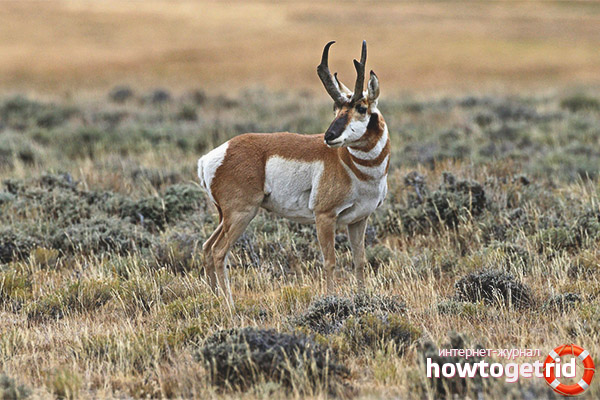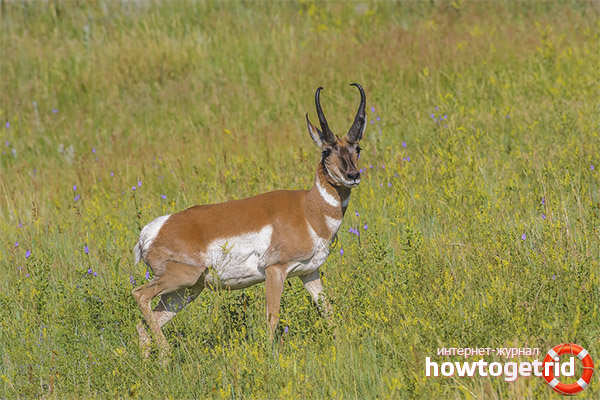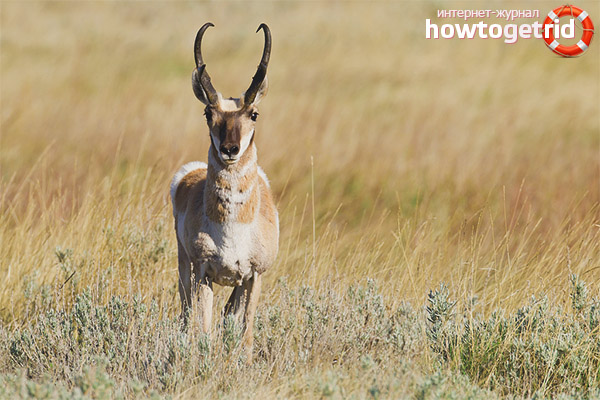The content of the article
The savannahs, forests and prairies of North America are home to a large number of animals, including ungulates. One of the oldest is considered to be a pronghorn antelope that has been living on the North American continent since the distant Pliocene times (10-12 million years ago). True, in those distant times there were more than 70 species of these animals, and only one survived to our time. And then, he was almost destroyed at the beginning of the 20th century. But, thank God, people had the wisdom not to exterminate this beauty.
Description
The pronghorn immediately looks like two ungulates - a little like a chamois, a little like an antelope. The animal is rather slender, one might even say it is beautiful, looks somewhat like a chamois. The body is about 130 centimeters in length, the height at the withers reaches one meter, and the mass depending on age is from 30 to 65 kilograms. Females are usually smaller than males.
The back is colored reddish-brown, the belly and lower side are white. The throat is decorated with a white speck in the shape of a semicircle.
The muzzle is elongated, slightly elongated, like all ungulates. The top is black, which creates the effect of a mask dressed in a beast. Big eyes are able to see absolutely everything around - the view of the animal is 360 degrees.
On the front legs are pads, consisting of cartilaginous growths, their role is to protect the animal's legs from damage and wounds caused by sharp prickly stones.
Horns
Once a year, when the race ends, a change occurs - the pride that has grown over the year is reset, leaving behind only a small foundation on which new branching formations grow over the winter. The growth process lasts about 4 months and ends in the spring - the horns, reaching 30 centimeters, are no longer extended, their growth stops.
Habitat
Pronghorn antelopes are common throughout North America, from southern Canada to the northernmost Mexican states. For living, the animal chooses steppe areas with a hilly landscape, the main condition is that no further than 3-5 kilometers from the habitat is a source of water.
Lifestyle
In summer they keep in small groups, and in autumn and winter, pronghorns form large (more than a hundred individuals) herds and slowly move across the mainland to places rich in food and water. Migration can be up to 300 kilometers long, and always goes along the same route - it remains unchanged for many years. The leader is always the female, and the male goes behind the herd and drives the lagging and weakened.
Upon arrival to a new place rich in food, the herd may dissolve - young grown males organize new groups, while females form separate groups.
Males aged live on their own and stay away from the herd, nevertheless, making a migration with him.
Animals are very undemanding to water and drink no more than once a day. For a long time they can do without water at all, they only need to eat succulent plants - this will saturate their body with moisture for a long time.
They can not be definitely attributed to day or night animals - they feed at any time of the day or night, they become especially active during sunrise.They sleep for an hour or two, having found thickets of low-growing shrubs and hiding under them.
The mode of life is as follows: two hours are allotted for feeding, then an hour and a half - sleep and again feeding until noon. Then a long rest until 16-17 hours, and again feeding before sunset. According to this schedule, pronghorns live from generation to generation.
Food
Pronghorns are one hundred percent herbivores. They eat all the grass growing on the territory of their habitat, moreover, they feed on plants that serve as poison for cows, sheep and other livestock. The diet varies according to the seasons and depends on the habitat. That is - in the north of the mainland, it will be different from what animals eat in the southern regions. As a rule, the food is shrubs, all kinds of herbs, lichens growing in the southern regions of the mainland cacti. He likes to pick up fruits that have fallen from the trees, eagerly nibbles young tree shoots, eats flowers. Favorite plant is sage.
Breeding

Pronghorns are polygamous animals. Maturity occurs in 15-16 months, but males enter into marriage only in the fourth year of life, and females in the third. Their race starts in August and lasts about two weeks. The herd breaks up, and the males begin to fight for the possession of the female, the fights are quite serious and traumatic, sometimes even end tragically - one of the rivals dies. The winner collects a small harem of up to 15 females, which have to be protected from rivals.
Children
Pregnancy lasts around eight months. As a rule, one cub is born, sometimes twins. A newborn calf is absolutely helpless, not very large - about 4 kilograms, has a grayish-brown color. At first, they hide from dangers in the thickets of grass where they lie, because the legs are very weak and there is no strength to stand. Mother comes to them four times a day and feeds them with milk. Three weeks after birth, the calf is already eating grass, but the mother continues to feed for up to three months.
In a month and a half, a stronger baby spills into the herd. After the mother stops feeding, the children are almost like adults and lead the same way of life.
Security
Man has hunted a lot of hornbills, and this has led to a significant reduction in this species. But the US government has passed tough laws governing the shooting and trapping of animals. Thanks to this, the number increased to almost a million individuals and the species does not threaten extinction. However, the pronghorn is listed in the International Red Book.
Interesting Facts
The difference between females and males manifests itself even in maternal feeding: mother feeds female children 15-20 days longer than boys.
Although these antelopes can jump well, any obstacle above one meter represents an insurmountable obstacle for them that cannot be overcome in any way. So, once in a fenced area, animals may well starve to death, even if there is a flowering meadow outside.
Pronghoruses communicate with each other using sounds. Cubs emit bleating, calling their mother, adult sexually mature males, starting a fight, roar loudly and lingeringly, mothers call babies also gentle bleating.











Submit